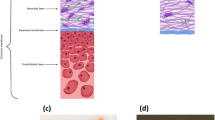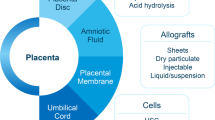Abstract
Diabetic patients have impaired wound repair due to decreased fibroblast infiltration, growth factor production, and angiogenesis. Decellularized human amnion/chorion placental connective tissue matrix (PCTM) has high levels of extracellular matrix components, is rich in growth factors that promote angiogenesis, and has anti-inflammatory properties, so it was hypothesized that PCTM could enhance healing in diabetic rats. Fibroblasts were cultured in a 10% PCTM solution, and controls were unaugmented. Real-time PCR and thymidine and proline uptake were used to determine fibroblast proliferation and collagen type I synthesis, respectively. Two dorsal dermal lesions were subsequently induced in eighteen diabetic rats. One lesion was untreated; the other was covered with PCTM or porcine small intestinal submucosa (SIS) and secured with sutures. Rats were sacrificed 1, 2, or 3 weeks postoperatively and analyzed on macroscopic appearance, fibrosis, epithelialization, and inflammation. In vitro placental augmentation resulted in a six-fold increase in collagen synthesis and a significant increase in fibroblast proliferation. In vivo PCTM treatments significantly increased epithelialization without increasing inflammation. PCTM-treated wounds had re-epithelialized within 2 weeks, whereas SIS treatments required three. These results indicate that PCTM accelerates healing due to enhanced fibroblast proliferation and collagen type I production. Diabetes is a challenging wound repair model; as such PCTM may have implications for treating injuries in both diabetic and healthy patients.








Similar content being viewed by others
References
Center for Disease Control. National Diabetes Statistics Report, 2014. http://www.cdc.gov/diabetes/pubs/statsreport14/national-diabetes-report-web.pdf. Accessed 1: 2014
Center for Disease Control. Diabetes Fact Sheet. http://www.cdc.gov/features/diabetesfactsheet/. Accessed 2: 2018
Schilling JA. Wound healing. Surg Clin North Am. 1976;56(4):859–74.
Werner S, Grose R. Regulation of wound healing by growth factors and cytokines. Physiol Rev. 2003;83(3):835–70.
Gottrup F. Oxygen in wound healing and infection. World J Surg. 2004;28(3):312–5.
Lerman OZ, Galiano RD, Armour M, Levine JP, Gurtner GC. Cellular dysfunction in the diabetic fibroblast: impairment in migration, vascular endothelial growth factor production, and response to hypoxia. Am J Pathol. 2003;162(1):303–12.
Knighton DR, Fiegel V. Growth factors and repair of diabetic wounds. In: Levin ME, O'neal LW, Bowker JH, editors. The diabetic foot. 5th ed. St. Louis: Mosby Year Book; 1993. p. 247–57.
Esser JS, Rahner S, Deckler M, Bode C, Patterson C, Moser M. Fibroblast growth factor signaling pathway in endothelial cells is activated by BMPER to promote angiogenesis. Arterioscler Thromb Vasc Biol. 2014;35(2):356–367
Hoeben A, Laduyt B, Highley MS, Wildiers H, Ban Oosterom AT, De Bruijn EA. Vascular endothelial growth factor and angiogenesis. Pharmacol Rev. 2004;56(4):549–80.
Koob TH, Lim JJ, Massee M, Zabek N, Rennert R, Gurtner G, et al. Angiogenic properties of dehydrated human amnion/chorion allografts: therapeutic potential for soft tissue repair and regeneration. Vasc Cell. 2014;6:10.
Rice JB, Desai U, Cummings AK, Birnbaum HG, Skornicki M, Parsons NB. Burden of diabetic foot ulcers for Medicare and private insurers. Diabetes Care. 2014;37(3):651–8.
Phillips T, Tanton B, Provan A, Lew R. A study on the impact of leg ulcers on quality of life: financial, social, and psychologic implications. J Am Acad Dermatol. 1994;31(1):49–53.
Koob TJ, Rennert R, Zabek N, Massee M, Lim JJ, Temenoff JS, et al. Biological properties of dehydrated human amnion/chorion composite graft: implications for chronic wound healing. Int Wound J. 2013;10(5):493–500.
Koob TJ, Lim JJ, Zabek N, Massee M. Cytokines in single layer amnion allografts compared to multilayer chorion allografts for wound healing. J Biomed Mater Res B Appl Biomater. 2014;102(6):1353–1362
Arocho A, Chen B, Ladanyi M, Pan Q. Validation of the 2-DeltaDeltaCT calculation as an alternate method of data analysis for quantitative PCR of BCR-ABL P210 transcripts. Diagn Mol Pathol. 2006;15(1):56–61.
Cook EA, Cook JJ, Badri H, Mostafa J. Bioengineered alternative tissues. Clin Podiatr Med Surg. 2014;31(1):89–101.
Zelen CM, Gould L, Serena TE, Carter MJ, Keller J, Li WW. A prospective, randomised, controlled, mulit-center comparative effectiveness study of healing using dehydrated human amnion/chorion membrane allograft, bioengineered skin substitute or standard of care for treatment of chronic lower extremity diabetic ulcers. Int Wound J. 2014;11(2):122–128
Author information
Authors and Affiliations
Corresponding author
Ethics declarations
Conflict of Interest
Daniel A Grande holds stock options in Aedicell.
Additional information
Publisher’s Note
Springer Nature remains neutral with regard to jurisdictional claims in published maps and institutional affiliations.
Rights and permissions
About this article
Cite this article
Schwartz, J., Koutsoumbelis, S., Parikh, Z. et al. The Use of Human Amnion/Chorion for the Enhancement of Collagen Synthesis and Acceleration of Wound Healing in a Diabetic Rat Model. Regen. Eng. Transl. Med. 7, 41–46 (2021). https://doi.org/10.1007/s40883-020-00156-0
Received:
Revised:
Accepted:
Published:
Issue Date:
DOI: https://doi.org/10.1007/s40883-020-00156-0




